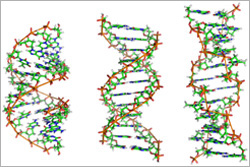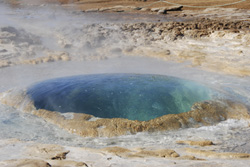
DNA researcher Rosalind Franklin ![]() first described an unusual form of DNA called the A-form in the early 1950s (Franklin, who died in 1958, would have turned 95 next month). New research on a heat- and acid-loving virus has revealed surprising information about this DNA form, which is one of three known forms of DNA: A, B and Z.
first described an unusual form of DNA called the A-form in the early 1950s (Franklin, who died in 1958, would have turned 95 next month). New research on a heat- and acid-loving virus has revealed surprising information about this DNA form, which is one of three known forms of DNA: A, B and Z.
“Many people have felt that this A-form of DNA is only found in the laboratory under very non-biological conditions, when DNA is dehydrated or dry,” says Edward Egelman ![]() in a University of Virginia news release
in a University of Virginia news release ![]() about the recent study. But considered with earlier studies on bacteria by other researchers, the new findings suggest that the A-form “appears to be a general mechanism in biology for protecting DNA.”
about the recent study. But considered with earlier studies on bacteria by other researchers, the new findings suggest that the A-form “appears to be a general mechanism in biology for protecting DNA.”
A team led by Egelman of the University of Virginia and David Prangishvili ![]() of the Pasteur Institute in Paris studied the virus SIRV2. It infects Sulfolobus islandicus, a microbe that lives in acidic Icelandic hot springs with temperatures topping 175 degrees Fahrenheit. The rod-shaped virus consists of a double-stranded DNA molecule and thousands of copies of a small, DNA-binding protein that forms a shell, or capsid, around the virus’ genetic material.
of the Pasteur Institute in Paris studied the virus SIRV2. It infects Sulfolobus islandicus, a microbe that lives in acidic Icelandic hot springs with temperatures topping 175 degrees Fahrenheit. The rod-shaped virus consists of a double-stranded DNA molecule and thousands of copies of a small, DNA-binding protein that forms a shell, or capsid, around the virus’ genetic material.

To determine the virus’ three-dimensional structure in detail and look for clues to how it survives heat and acid, the researchers used a technique called cryo-electron microscopy (cryo-EM). They found that in the virus, a portion of the capsid protein folds into a corkscrew-shaped structure that wraps tightly around the DNA. More surprising, the cryo-EM analysis showed that the virus stores its DNA in the A-form—a more compact, squashed version of the B-form DNA usually seen in nature. The researchers suspect that storing genetic material in the A-form may help the virus survive brutal conditions.
The study also pointed to unexpected similarities between SIRV2 and the spores certain disease-causing and other bacteria form to survive in inhospitable environments. Earlier work by others showed that, similar to the SIRV2 capsid protein, DNA-protecting proteins in bacterial spores cause a shift from B-DNA to A-DNA when they bind to the bacterial DNA. More recently, scientists not involved in the current study found that DNA from four different species of bacteria transitioned from the B-form to the A-form and back to B when the bacteria were dried out and then revived from their dormant state.
“You see A-form DNA both in certain bacterial spores and in a virus that survives extreme conditions, but their DNA sequences are different,” says biophysicist Paula Flicker of NIGMS. “That supports the idea that assuming the A-form may be part of the way that the spores as well as SIRV2 survive harsh conditions.”
Egelman says that understanding how these bacterial spores work could potentially lead to new ways to destroy them. “Having this basic scientific research leads in many, many directions, most of which are impossible to predict, in terms of what the implications are going to be.”

